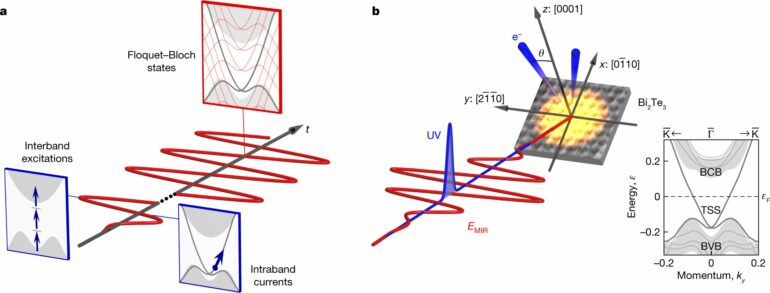Since ancient times, mankind has tried to tailor materials by combining different substances. Imagine a world where materials properties could be flexibly changed on demand by simply shining light onto them. A group of physicists from across Europe has now made a decisive step towards this goal by dressing electrons moving in a solid with light.
The team, which includes researchers from the Universities of Regensburg and Marburg, the Max Planck Institute for Structure and Dynamics of Matter in Hamburg, the Paul Scherrer Institute in Villigen, Switzerland, and others, observed for the first time how exotic states, known as Floquet bands, arise in a crystal. The discovery, which has been published in Nature, could revolutionize the way we think about material properties.
“The discovery of new material properties usually depends on our ability to control the chemical composition of the material,” said Marburg physicist Prof. Dr. Ulrich Höfer, a lead author of the paper who also holds an adjunct professorship at University of Regensburg. “Purely optical manipulation of material properties could take physics into a new era by enabling new functionalities on demand.”
The team used the method of angle-resolved photoemission spectroscopy to study the surface electrons of the topological insulator bismuth telluride. In this material, the electrons can move ballistically for long times without scattering. By employing intense light pulses, the researchers could drive these electrons periodically through the crystal.
This led to an exotic quantum effect, causing the electrons to have not just one fixed energy state, but many energy states evenly spaced apart by the driving photon energy. These so-called Floquet bands are hybrids between electrons and light. “However, the dynamic properties of such states have remained elusive until now,” explains Regensburg physicist Prof. Dr. Rupert Huber, another lead author.
The team’s measurements went far beyond the limit of what could be achieved to date with this technique. They managed to take actual videos of the moving electrons with a time resolution better than a single oscillation cycle of the electromagnetic carrier wave of light. As a result, they made an unforeseen discovery: “Surprisingly, Floquet bands form already after a single optical cycle,” says Dr. Suguru Ito, the first author of the publication. “Our experiment opens up the possibility of visualizing a large number of transient quantum states,” adds Huber. “This paves the way to tailored quantum functionalities and ultrafast electronics.”
The experimental findings are supported by theoretical modeling contributed by Dr. Michael Schüler of the Paul Scherrer Institute in Villigen, Switzerland, and Dr. Michael Sentef of the Max Planck Institute for Structure and Dynamics of Matter in Hamburg, Germany.
Having established the fundamental time limit for light-induced material engineering, the team’s breakthrough discovery could lead to a new era of materials science, enabling the creation of new functionalities on demand. Following this avenue, Prof. Dr. Ulrich Höfer and Prof. Dr. Rupert Huber were recently jointly awarded an ERC Synergy Grant from the European Research Council for their “Orbital Cinema” research project, which aims to take slow-motion videos of electronic motion in quantum mechanical orbitals of single molecules and atoms.
More information:
S. Ito et al, Build-up and dephasing of Floquet–Bloch bands on subcycle timescales, Nature (2023). DOI: 10.1038/s41586-023-05850-x
Provided by
University of Regensburg
Citation:
A team of physicists watches electrons getting dressed with light (2023, April 12)



